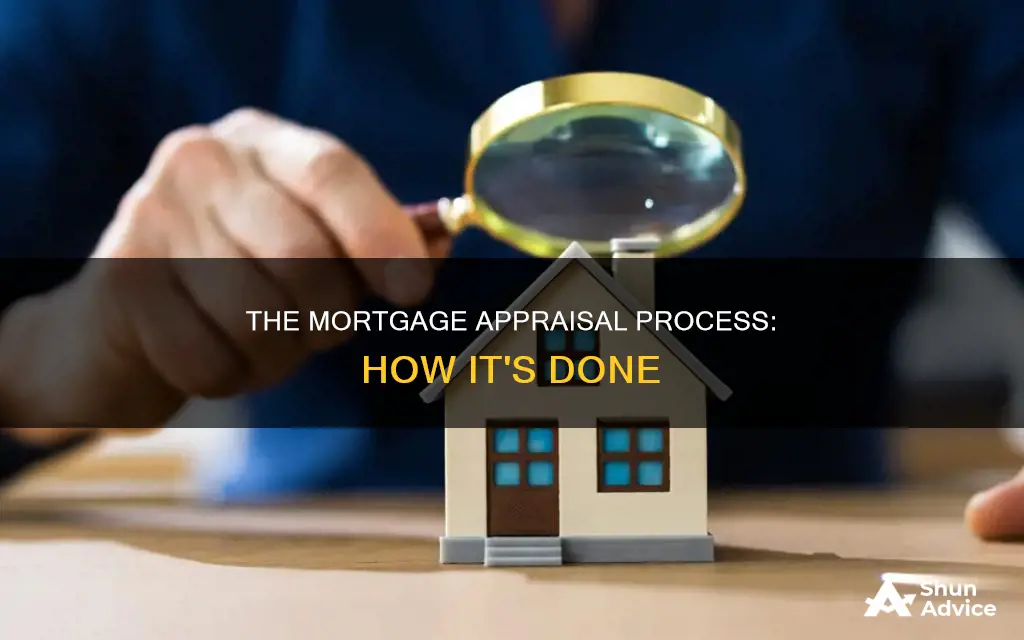
A home appraisal is an essential part of the mortgage process, providing an unbiased estimate of a property's market value. It is typically arranged by the mortgage lender to ensure the loan amount does not exceed the property's value, reducing the risk of overborrowing. The appraisal fee, averaging $300 to $500, is usually paid by the buyer at closing or upfront. A licensed appraiser conducts a thorough inspection, considering factors like property size, condition, upgrades, comparable sales, and market trends to determine the property's worth. A low appraisal can impact the loan amount, requiring the buyer to make up the difference or renegotiate with the seller. Conversely, a high appraisal benefits the buyer by increasing their home equity. Understanding the home appraisal process is crucial for buyers, sellers, and lenders to make informed decisions and ensure a smooth transaction.
| Characteristics | Values |
|---|---|
| Purpose | To determine the value of a property |
| Who arranges it | Mortgage lenders |
| Who pays for it | Home buyers |
| When is it paid | At closing |
| Who performs it | Licensed or certified appraiser |
| What they consider | Property's size, features, condition, comparable sales in the area, and any upgrades or additions made to the property |
| Cost | Between $300 and $550 |
| Time taken | Two weeks on average |
What You'll Learn
- Mortgage lenders arrange appraisals to determine loan amounts
- Appraisers consider property size, features, condition, and location
- A low appraisal may require the buyer to make up the difference in cash
- Appraisal fees are usually paid by the buyer at closing
- Appraisals can be delayed by issues like roof, pest, or water damage

Mortgage lenders arrange appraisals to determine loan amounts
A home appraisal is an essential component of any real estate transaction. It is a professional opinion of a property's value, performed by a licensed appraiser. Mortgage lenders arrange appraisals to determine loan amounts and ensure they are not lending more than a property is worth.
The appraiser will consider various factors that could affect the property's value. These include the property's size, condition, location, and any upgrades or additions made. They will also look at comparable sales in the area, also known as "comps", to determine the property's fair market value. The appraisal fee is usually paid by the buyer at closing, but it can sometimes be paid upfront or negotiated for the seller to pay.
The appraisal value of a home directly impacts the loan amount a buyer can qualify for. If the appraisal comes in lower than the purchase price, the buyer will need to make up the difference in cash or renegotiate the price with the seller. In some cases, a low appraisal can delay or even derail a home purchase. On the other hand, if the appraisal comes in higher than expected, it can benefit both the buyer and the seller by building more home equity from the start and allowing the sale to move forward quickly and smoothly.
Mortgage lenders require appraisals to gauge the risk of making a loan. The property serves as collateral in case the borrower defaults on the loan, so lenders want to ensure the loan amount is not more than the property's value. While most lenders arrange and schedule the appraisal, they may hire a third-party appraisal management company (AMC) to maintain impartiality. The AMC then hires the appraiser on the lender's behalf.
Understanding Conversion Mortgage Repayment: What You Need to Know
You may want to see also

Appraisers consider property size, features, condition, and location
A home appraisal is a critical step in the home-buying process, as it determines the value of a home. The appraiser will consider the property's size, features, condition, and location, among other factors, to estimate its fair market value.
The property's size is an essential factor in the appraisal process. Appraisers will take into account the lot size and the gross living area of the home. They will also consider any structural improvements, such as additions or remodelled rooms, that may impact the overall size and value of the property.
The features of a property can also influence its appraisal value. Special features, such as a pool, or other amenities, can increase the property's value. Upgrades and improvements, such as the addition of central air or new landscaping, can also add value. However, it is important to note that regular maintenance, such as replacing a broken air conditioner, is not considered an improvement and may not impact the appraisal value.
The condition of the property is another key factor in the appraisal process. Appraisers will look for any signs of potential issues and may order additional inspections, such as roof, pest, or water inspections, if necessary. If the appraisal uncovers conditions that do not meet the lender's requirements, these may need to be repaired before the lender can approve the mortgage.
Finally, the location of the property is also considered in the appraisal. Appraisers will analyse recent sales of comparable properties in the area, taking into account the neighbourhood's market trends and conditions. A newer home in a growing subdivision may appraise higher than an older home in a community that is in decline. Additionally, the property's proximity to certain amenities or undesirable external structures, such as power lines, can also impact its appraisal value.
Salary vs. Bonus: What Lenders Focus on for Mortgages
You may want to see also

A low appraisal may require the buyer to make up the difference in cash
A home appraisal assesses a property's fair market value. It is an essential component of any real estate transaction, as it determines the value of a home and impacts the home sale price and a buyer's loan amount. Lenders request home appraisals to ensure borrowers aren't borrowing more than a home is worth, reducing the risk of overborrowing.
A low appraisal can delay or derail a home purchase. Since lenders won't lend more money than a property is worth, a low appraisal can present challenges for buyers relying on mortgage financing. In such cases, the buyer may need to make up the difference in cash between the contract price and the appraised value. This is known as the appraisal gap.
If the buyer cannot cover the gap, they may need to back out of the sale, potentially losing their earnest money deposit and facing legal action. Alternatively, they can try to negotiate a lower price with the seller or increase their down payment to reduce or eliminate the appraisal gap. In a seller's market, the seller may be less willing to lower the price, whereas in a buyer's market, the seller may be more motivated to renegotiate.
To avoid a low appraisal, sellers can prepare the home, be engaged in the process, and provide the appraiser with a list of upgrades and their completion dates. Buyers can also protect themselves by including an appraisal gap clause in the purchase agreement, stating that the buyer will cover the difference between the appraised value and the purchase price up to a certain amount.
The Underwriting Process: A Mortgage Deal-Maker or Breaker
You may want to see also

Appraisal fees are usually paid by the buyer at closing
A home appraisal assesses the fair market value of a house. It is an essential component of any real estate transaction, as it determines the value of a home and helps to ensure buyers don't pay more than a home is worth. Lenders usually request home appraisals to assess a home's value and ensure borrowers aren't borrowing more than the home is worth, reducing the lender's risk of overborrowing and the borrower's risk of overpaying.
Appraisal fees tend to range from $300 to $550, with the average price for an appraisal of a single-family home being $357. The final cost depends on factors such as the property's size, location, and condition, as well as the level of detail involved in the appraisal. A large home or property will typically cost more to appraise, as will properties in larger cities or areas with a higher cost of living.
The appraisal fee is usually paid by the buyer at closing, although buyers may be able to pay it upfront. Some buyers can negotiate for the seller to pay for the appraisal, but this is rare and usually occurs when the seller is employing a strategy to sweeten the deal and sell the home. The appraisal fee is one of the many closing costs that a buyer must consider when purchasing a home.
The appraisal process involves a licensed appraiser inspecting the property in person and comparing it to recently sold, similar homes in the area. They will consider factors such as the property's size, location, age, condition, and any amenities or special features. The appraisal report is then used by the lender to determine the loan-to-value ratio (LTV) and how much they can lend to the buyer.
Creating Collateralized Mortgage Obligations: A Step-by-Step Guide
You may want to see also

Appraisals can be delayed by issues like roof, pest, or water damage
A home appraisal is a critical step in the home-buying process, as it determines the value of a home and helps mortgage lenders ensure the home is worth the amount they are lending. Appraisers are trained to look for signs of pest infestations, water damage, and roof issues, among other things. These issues can lead to delays in the appraisal process and even cause lenders to refuse to proceed with the transaction.
Pests such as termites, bed bugs, rodents, or cockroaches indicate poor maintenance and pose threats to the structural integrity of the building and the health of future inhabitants. For example, termites can compromise the strength and safety of the structure by chewing through wood, and rodents can increase the risk of a fire by gnawing on electrical wiring. If not addressed, pest infestations can lead to a decrease in the appraised value of the home or cause lenders to refuse to move forward with the loan.
Water damage, whether from a leaky roof, burst pipes, or flooded basements, can also negatively impact a home's structural integrity and lead to a lower appraisal value. Even minor issues, like slight discolouration on the ceiling or a damp smell, can be red flags for appraisers and potential buyers. Water infiltration can cause further problems such as mould growth and insulation damage, which are health hazards and contribute to energy inefficiency.
Roof issues are another common problem that can delay mortgage appraisals. Appraisers typically look for missing or cracked shingles, sagging areas, and signs of water damage inside the home. A damaged roof indicates potential structural problems and the need for costly repairs, which can deter buyers and lenders. Conventional appraisers prefer to see at least two years of life left on a roof, and they may require certification from a roof inspector if the roof appears to be in poor condition.
In summary, issues like roof, pest, or water damage can cause delays in mortgage appraisals by affecting the perceived value of the property and raising concerns about potential health and safety risks. It is essential for sellers to address these issues before the appraisal to avoid delays or the need for renegotiations.
Mortgages: Understanding the High Cost of $1800 Monthly Payments
You may want to see also
Frequently asked questions
A mortgage appraisal is a report on the estimated fair market value of a home. It is usually requested by the lender when someone is using a mortgage to purchase a home or refinance their current mortgage.
A mortgage appraisal is done by a state-licensed appraiser who will coordinate a time for a home visit. The appraiser will take pictures of each room in the house and review the home's interior and exterior to make sure it is in sound structural shape, confirm that there aren't any safety issues, note the number of rooms, and see if there have been any major upgrades or renovations. The appraiser will also consider the location and size of the home, the lot size, the home's age and condition, and any special features of the home, like a pool.
The cost of a mortgage appraisal can vary depending on several factors, including the property's size, location, age, and condition. On average, a home appraisal for a single-family home can cost around $500, while the appraisal of a multifamily property can cost closer to $2,000.
After a mortgage appraisal, the appraiser will produce a report that will be shared with the lender and the borrower. The findings of the appraisal can influence the lender to trust the borrower with a higher loan amount or require the borrower to pay for private mortgage insurance (PMI) if the home equity is less than 20%appraisal comes in lower than expected, the borrower can challenge the appraisal or request a reconsideration of value from the lender.







